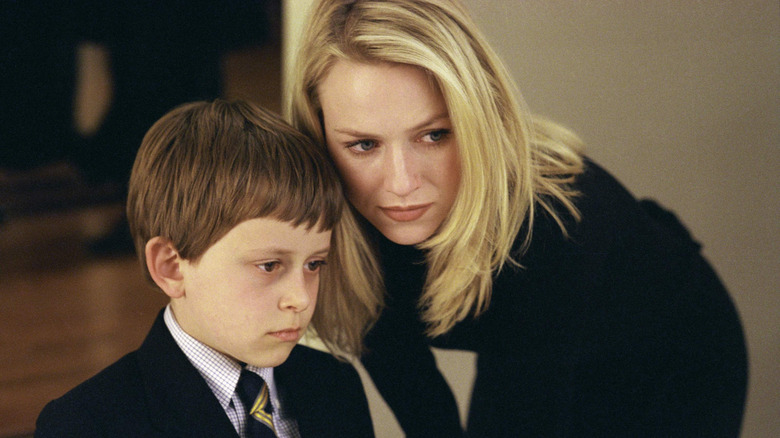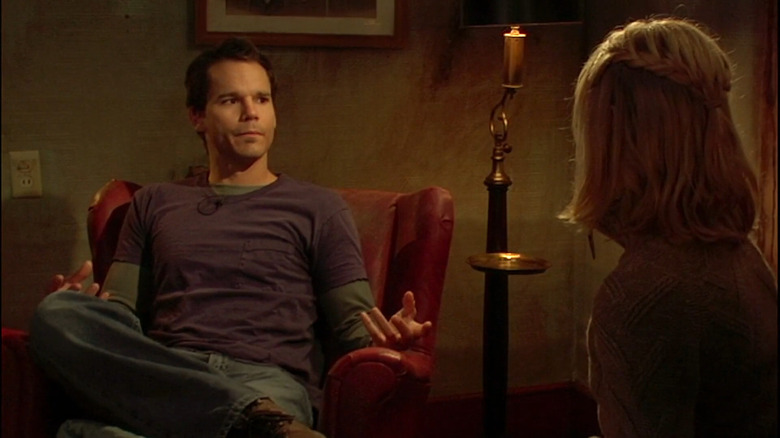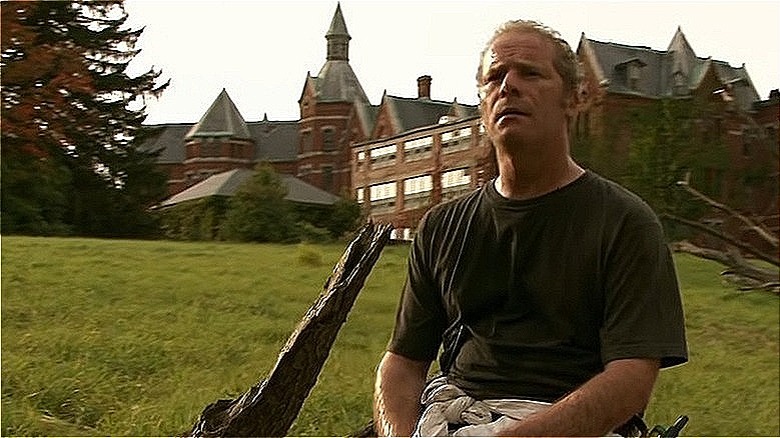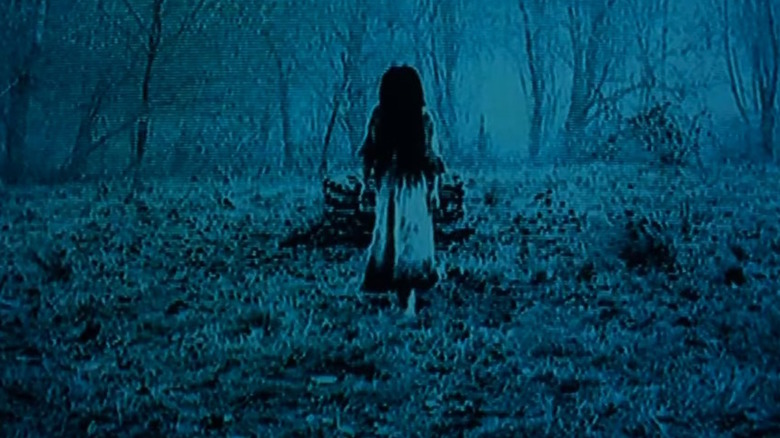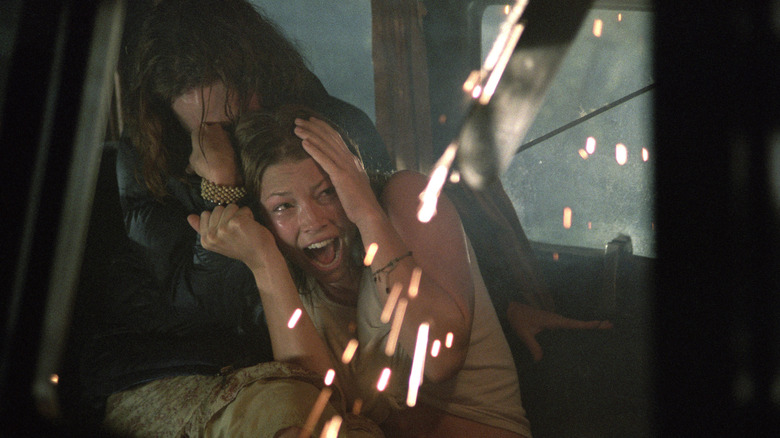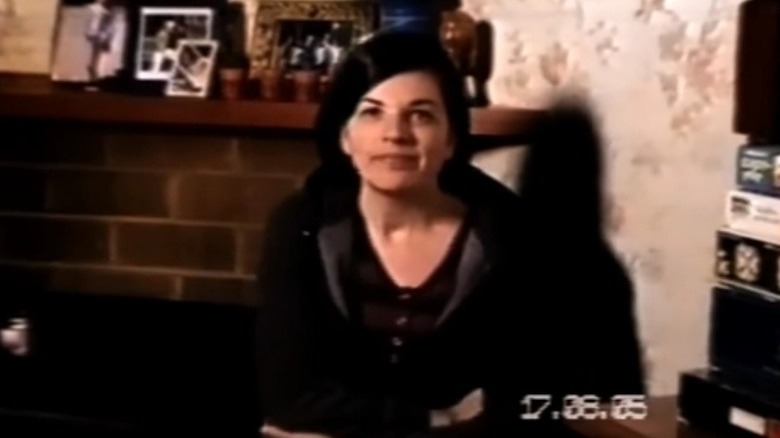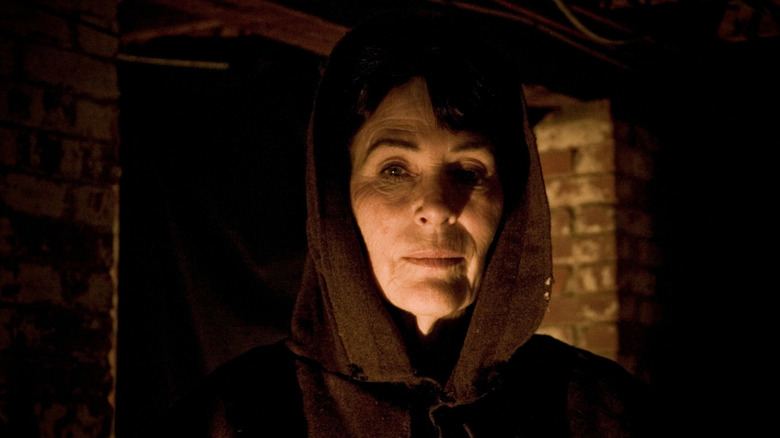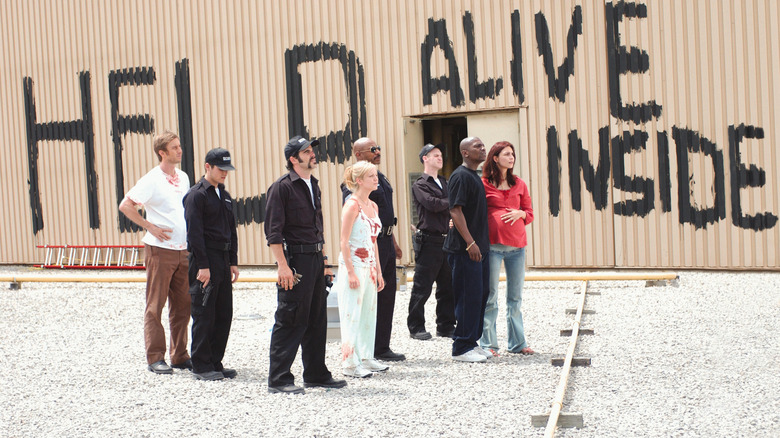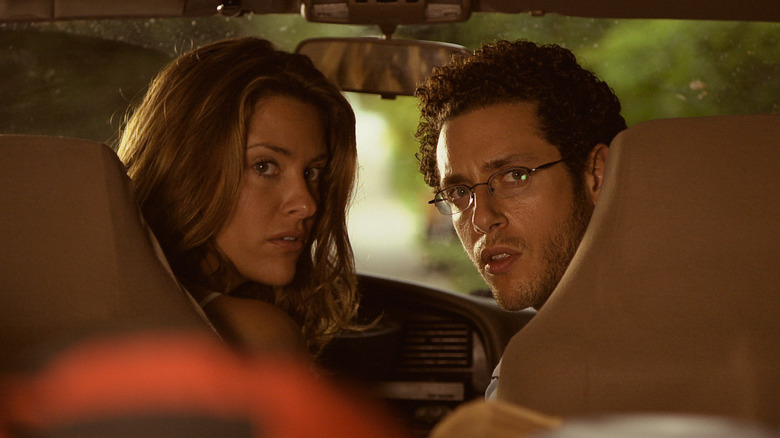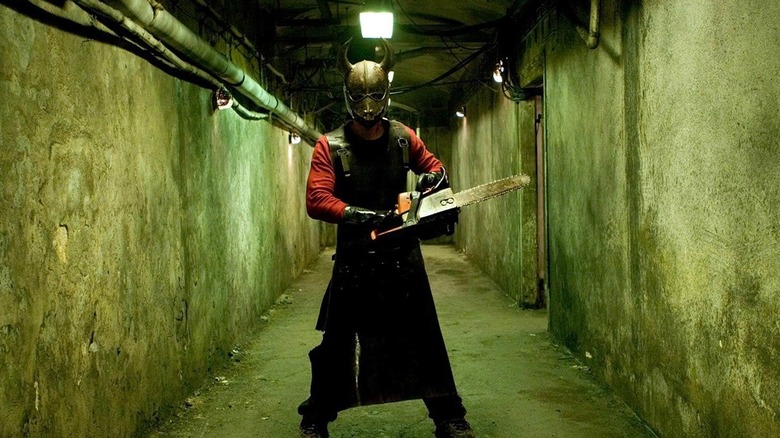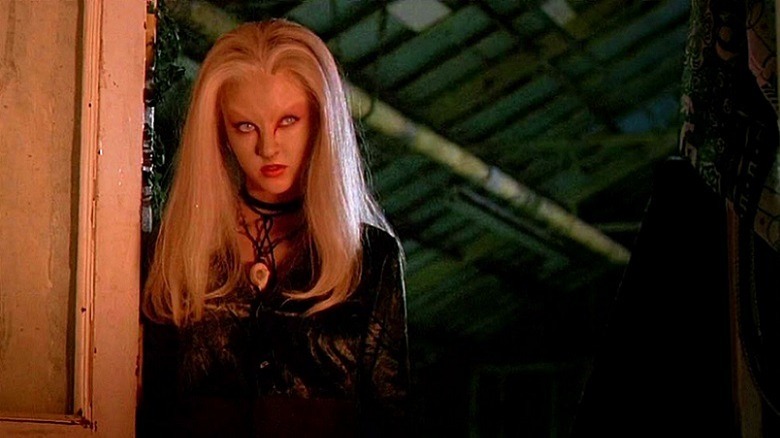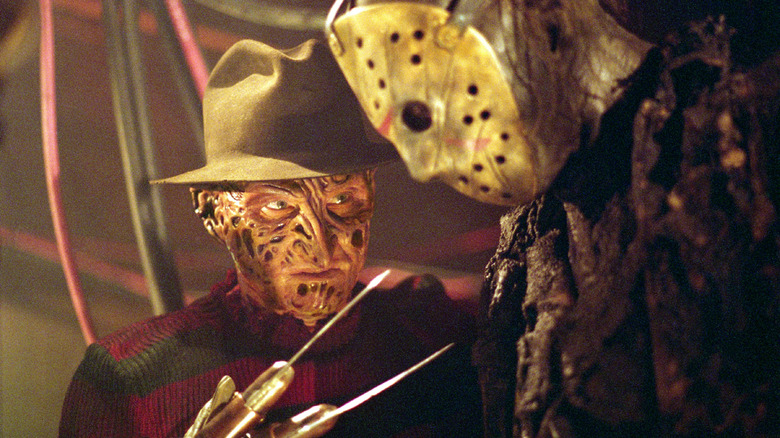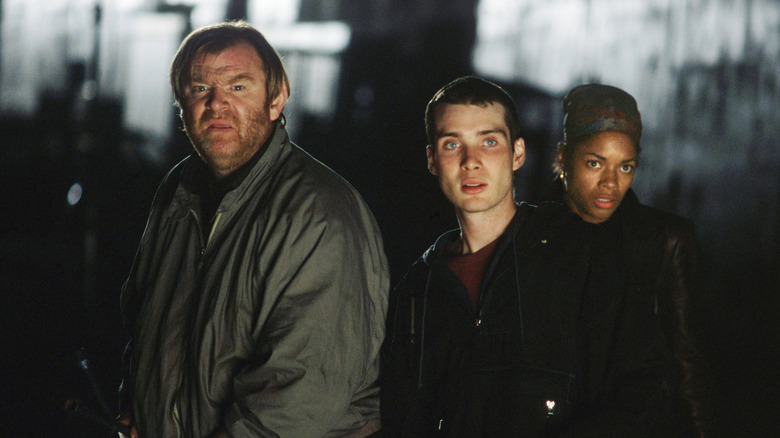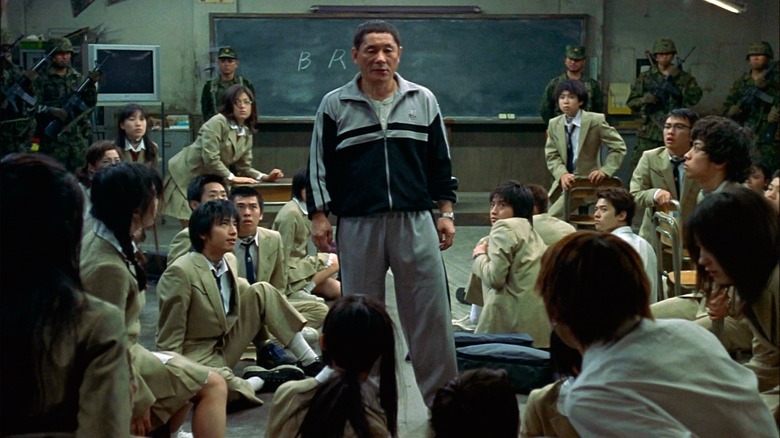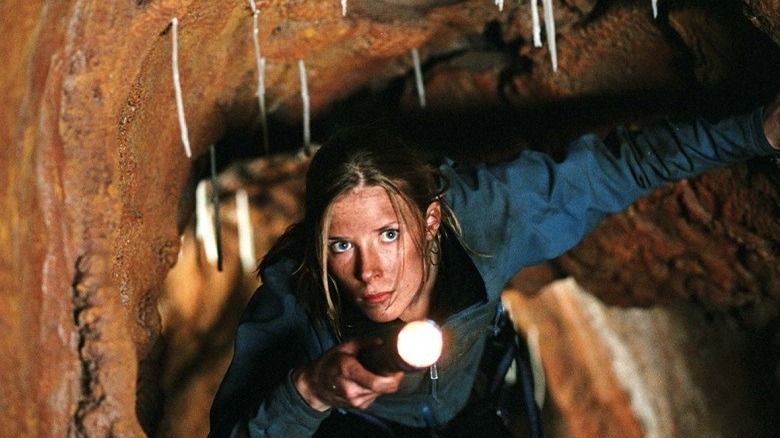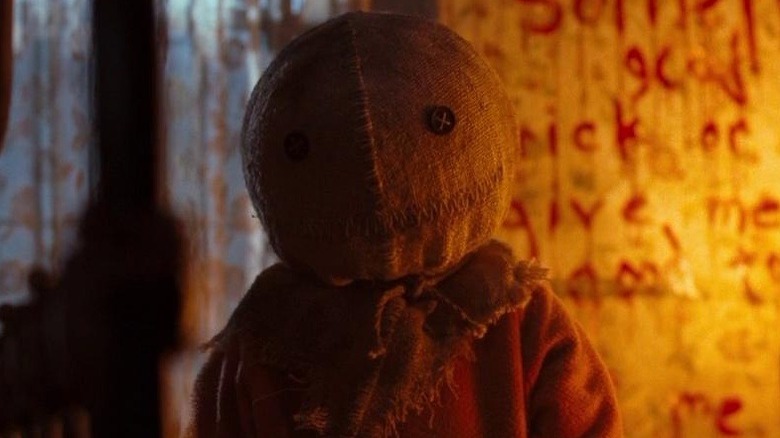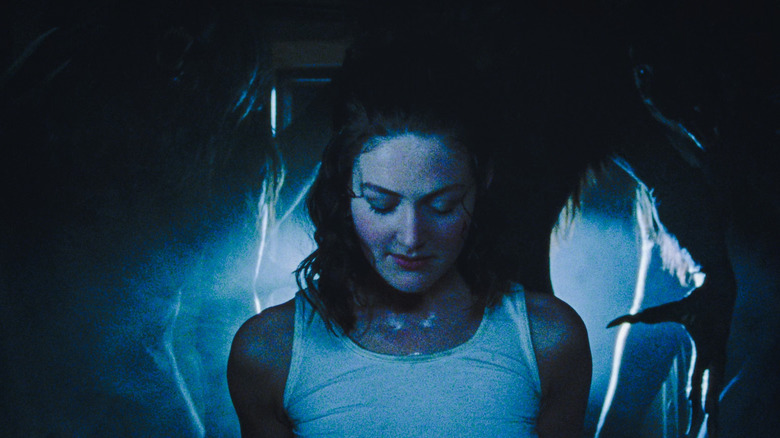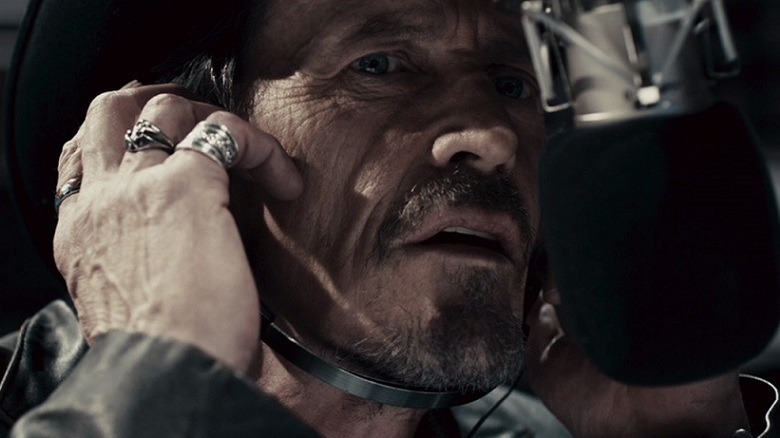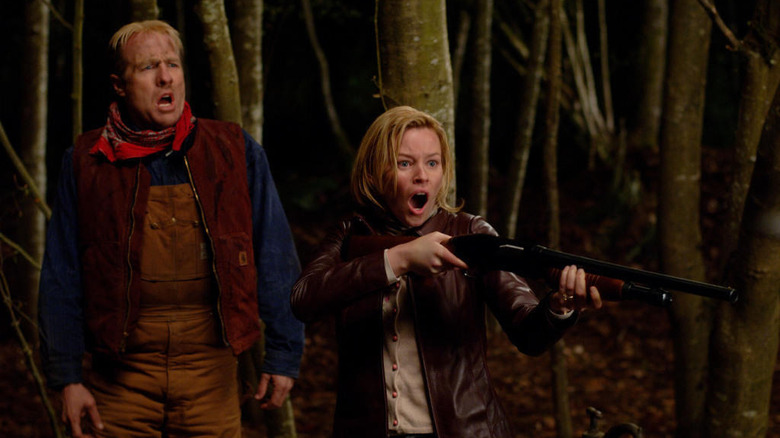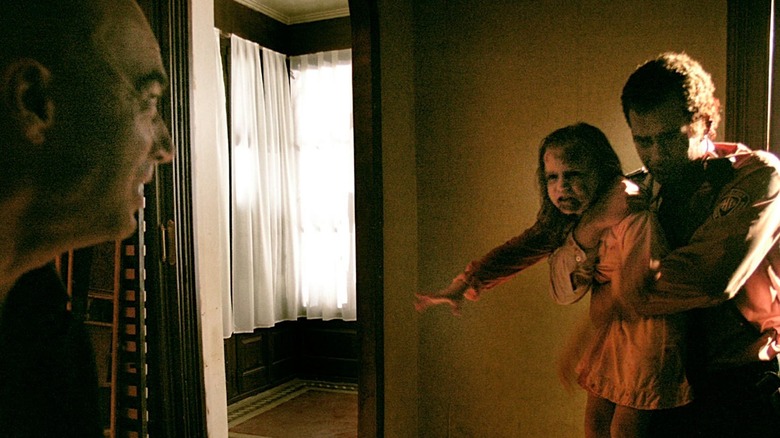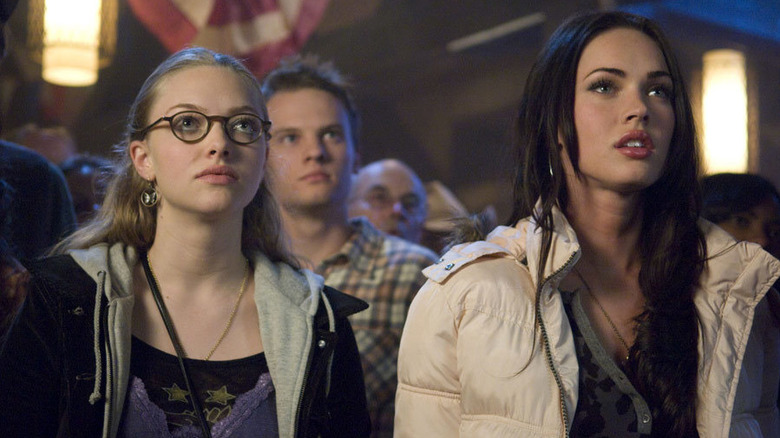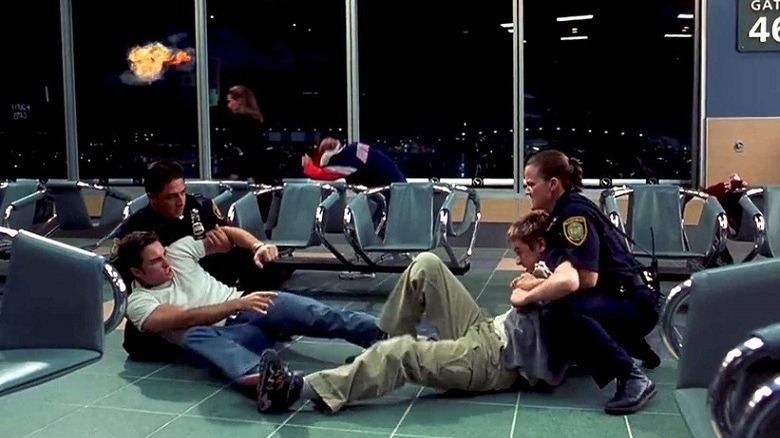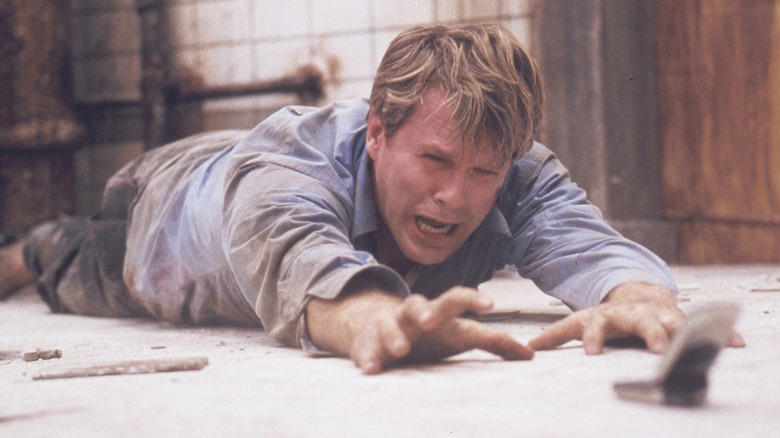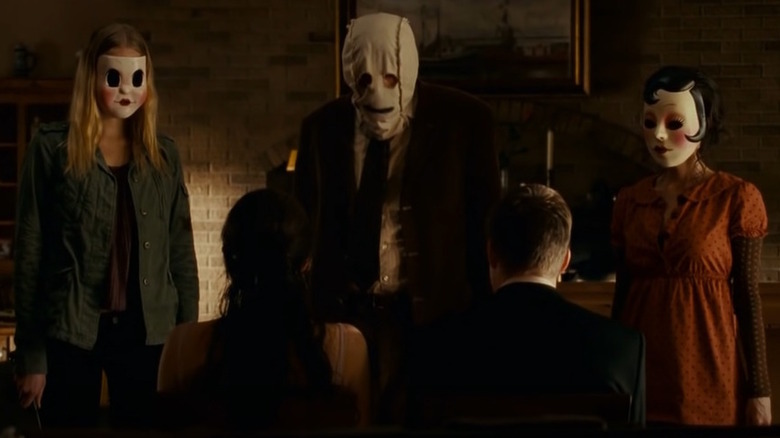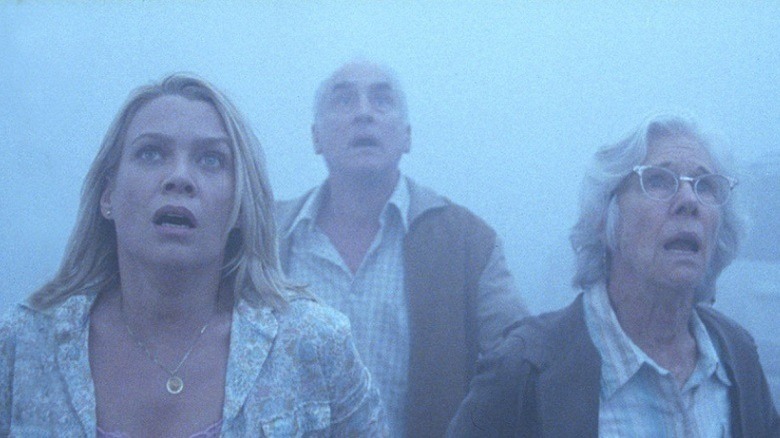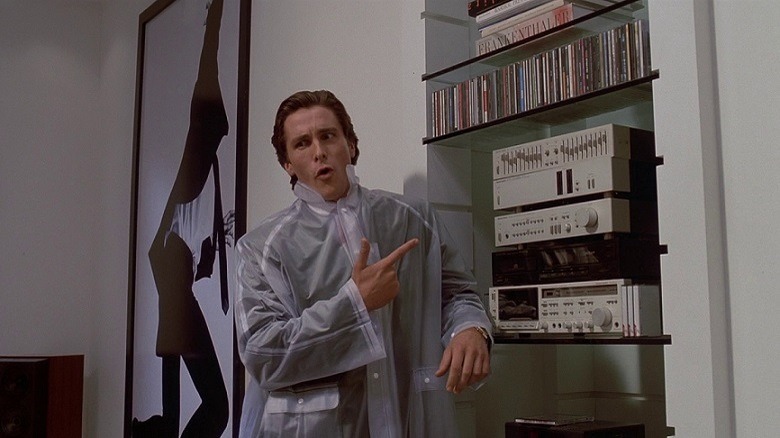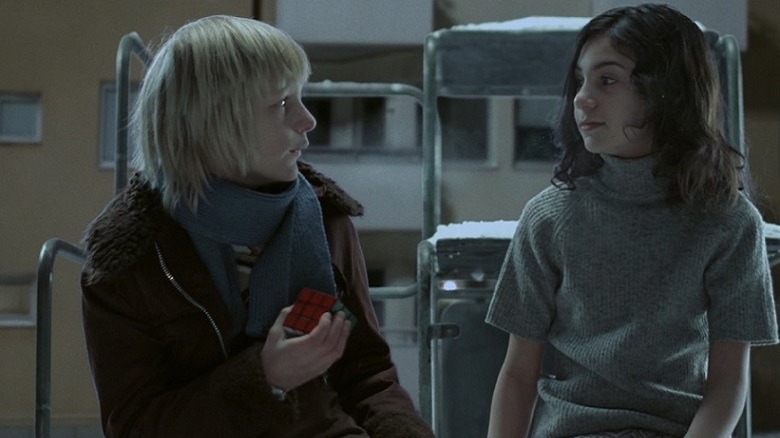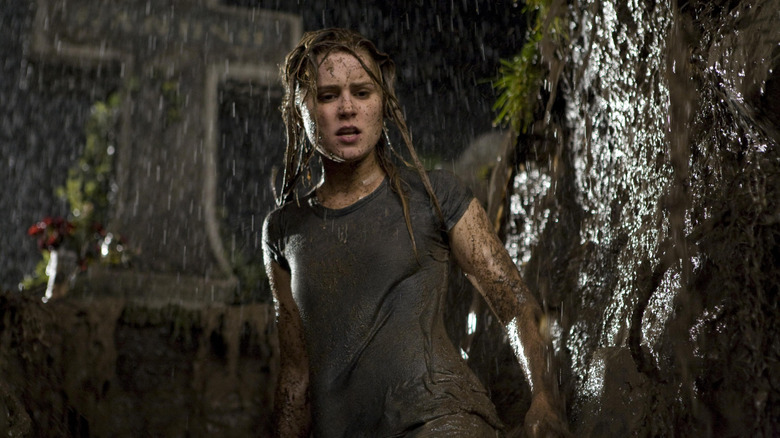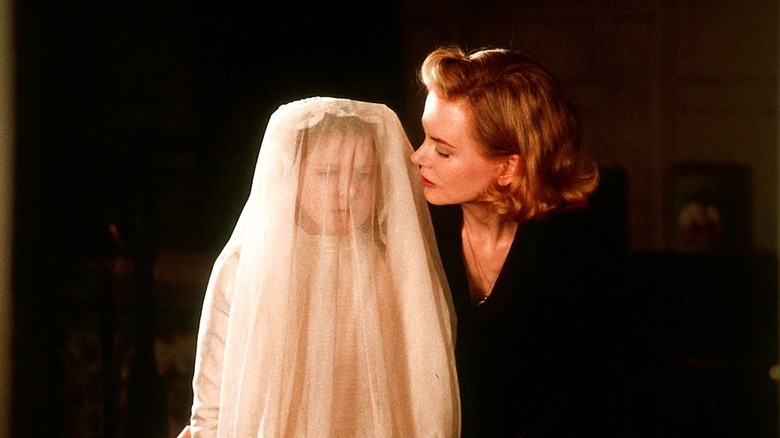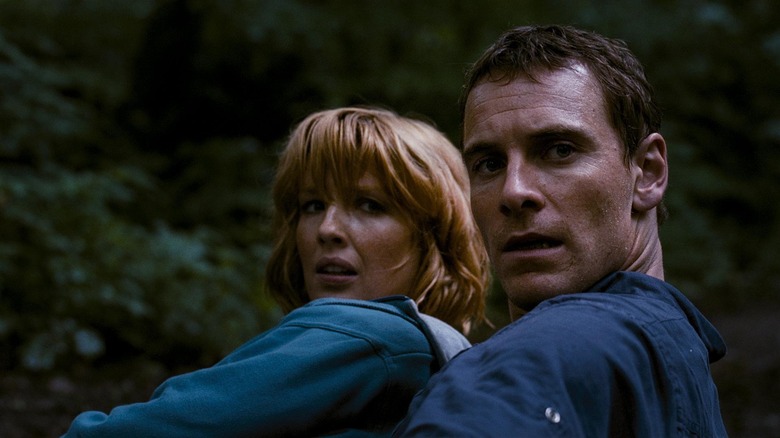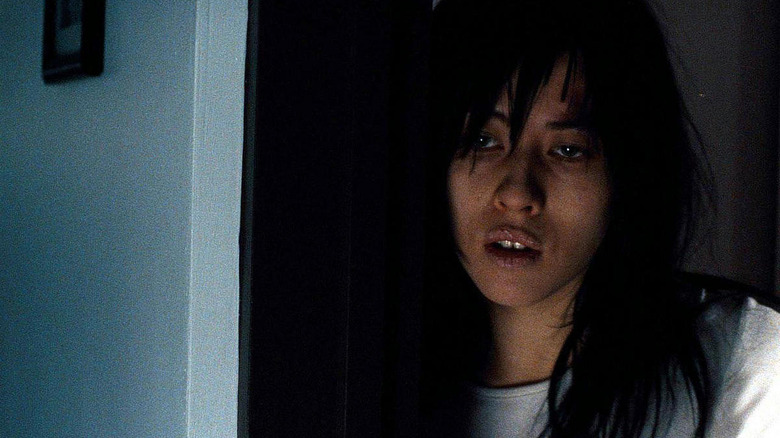The 30 Best 2000s Horror Movies Ranked
After the bountiful harvest the decade before, horror films fell into somewhat of a rut in the '90s. It was an era that saw the long overdue death of a number of once-lucrative franchises like Nightmare on Elm Street and Friday the 13th, thanks to sequels with lessening box office returns. However, a resurgence began with the dawn of the new millennium. With the emergence of digital film technology and affordable computing power, films were cheaper to make, while the internet was a brand new frontier for promoting and releasing movies.
Watching the grisly horrors of 9/11 and the Iraq War unfold in real time scarred the worldwide psyche, and a new breed of filmmakers were only too keen to exploit these anxieties with a frank and gritty approach to horror, one that was sometimes exploitative and offensive ("The Human Centipede"), sometimes grounded in brutally violent reality ("Saw", "Hostel"), and sometimes thoroughly nihilistic ("Martyrs"). Audiences became more sophisticated, and horror moved away from the stigma that had been unfairly attached to it in the '80s. Foreign — and subtitled — films grew more popular, as did the blurring of lines between genres. Horror films were becoming art.
So, drag yourself away from MySpace and TheFacebook and step back in time to the '00s, our Final Destination...
30. Behind the Mask: The Rise of Leslie Vernon (2006)
In the post-"Scream" world, slashers became wildly unpredictable. With "Behind the Mask: The Rise of Leslie Vernon," director Scott Glosserman guides viewers into the mouth of madness as it deconstructs Leslie Vernon's (Nathan Baesel) ambition to become a prolific serial killer. Shot in a mockumentary style, the film documents Vernon's each step toward achieving fame. Leslie seeks advice from veterans in the business and later exposes the behind-the-scenes tricks to delivering on the kill sequences.
The film inhabits a world in which horror icons like Freddy Krueger really exist. As such, Leslie has meticulously studied the greats to find his own unique path to the top. He enlists a journalist named Taylor Gentry (Angela Goethals) and her crew to record everything. Set in his rundown childhood home, Leslie rigs up the house as one might expect in typical horror movie fashion. He seals off certain entry points, removes potential weapons, and tinkers with the electricity. His well-laid plan goes off without a hitch, and he's well on his way to the infamy he so hungers for. A third-act revelation confirms he's even more of a genius than you might have suspected.
"Behind the Mask: The Rise of Leslie Vernon" flips convention on its head in every conceivable way. It retools slasher tropes for a self-referential examination of our obsession with serial killers and their crimes, forging something fresh and exciting. It's too bad it never quite took off with the general public.
29. Session 9 (2001)
"Session 9" relies heavily on haunted happenings to drive its story. Directed by Brad Anderson, who co-wrote the script with Stephen Gevedon, the film follows Gordon (Peter Mullan) and his asbestos clean-up crew. Tasked with removing the hazardous material from a dilapidated mental asylum, Gordon promises to have the job done in only a week. Such a heavy workload would normally take more time. His crew reacts appropriately, shaking their heads and scoffing. But they need the work, so they put their heads down and plow through the asylum.
On their first day, a disembodied voice greets Gordon by name, setting off a disturbing series of events. Things soon go awry when one of the crew disappears. It's the beginning of the longest week of their lives. Meanwhile, crew member Mike (Stephen Geved) discovers a box of tapes on which are numerous recordings of therapy sessions with a young girl who has a split personality disorder. These tapes hint at what's crawling beneath the surface of the asylum, but no one could anticipate what comes next for Gordon and the crew.
"Session 9" chillingly molds haunted house tropes in a darker clay. It's the kind of terror that swallows the viewer. Fortunately, jump scares are minimal. Instead, the film insidiously slithers into the pores.
28. The Ring (2002)
An Americanized version of Hideo Nakata's 1998 film Ringu, "The Ring," directed by Gore Verbinski, stars Naomi Watts (the queen of remakes) and David Dorfman. When a videotape that kills those who view it in seven days shows up, Rachel (Watts) and Aidan (Dorfman) become tangled in a dark and intricate web involving Samara Morgan, a young girl (Daviegh Chase) murdered by her mother. The videotape contains weird, unsettling imagery as clues to a much more unsettling story. The breadcrumbs lead to a farm on Moesko Island, where Rachel approaches a man named Richard (Brian Cox), who may have the answers she so desperately needs.
As is the case with "The Texas Chainsaw Massacre" (also on this list), "The Ring" honors the source material while delivering a unique perspective. During Rachel's journey, she mistakenly watches the tape as part of her research. As the mystery unravels, the water-logged little girl crawls closer and closer, and it's a race against time to survive. Rachel discovers that the girl, a tortured spirit, may not even be evil at all. The girl's motivations are unclear, but perhaps she just wants her story to be told and for her mother to, in some small way, pay for what she did. "The Ring" hooks the audience with creepy imagery and a surprisingly emotional core.
27. The Texas Chainsaw Massacre (2003)
During the remake heyday, "The Texas Chainsaw Massacre" sawed through the noise with a jagged edge. The 2003 reimagining pays tribute to Tobe Hooper's 1974 original while carving out something uniquely its own. Starring Jessica Biel and Eric Balfour, the film tells the harrowing tale of a group of young people on their way to a Lynyrd Skynyrd concert. They have the misfortunate of witnessing someone taking their life and are forced to contact local authorities. What starts as an act of goodwill mutates into a blood-drenched nightmare.
Sheriff Hoyt (R. Lee Ermey) emerges as one of the genre's best villains. With a penchant for violence, Hoyt takes the group hostage and forces their faces into the dirt. Desperate pleas for help pierce the night air. Blood soaks the road to death, and each moment is as nauseating as the next. Director Marcus Nispel leaves the grittiness of Hooper's original intact, yet there's a polish that makes it more widely appealing. Nispel delivers violence with visceral brutality, both in how its executed and the shocking aftermath. The director also suggests that Leatherface (Andrew Bryniarski) isn't a villain but a product of a broken, dysfunctional household.
"The Texas Chainsaw Massacre" remains one of the 2000s defining relics. It's a relentless tour de force of grotesqueness that never allows the audience a moment's peace. Much like "The Ring," it swings for the fences.
26. Lake Mungo (2008)
Fusing found footage and mockumentary style into a gripping, tragic tale about the disappearance of a young woman named Alice (Talia Zucker), "Lake Mungo" smacks you across the face. Alice's family searches for answers and, ultimately, travels down the rabbit hole of her sordid secret life. What transpires is an alarming glimpse into the unknown. Director Joel Anderson endears you to the characters in a heartbreaking way, so when strange sightings occur, you genuinely care. Interviews with close friends and family give deeper insight into the story and set up many of the scares. With each turn, Anderson ropes you in until the chilling conclusion.
Throughout "Lake Mungo," Anderson zigs when you expect him to zag. It's not only a film about Alice's disappearance but also about grief and processing emotions. Alice's brother, Matthew (Martin Sharpe), has a particularly difficult time and starts faking ghost videos to deal with what happened. Soon, an unknown entity haunts the family, fueling their pain. To get answers, the family hires a paranormal investigator, and what they capture on camera will chill the blood.
Found footage films often get painted with a broad brush, and "Lake Mungo" makes a compelling case for the entire genre. It's enthralling and wonderfully disturbing. It could have ranked higher, but the competition is stiff.
25. The House of the Devil (2009)
Director Ti West transports the audience back to another time and place. "The House of the Devil" feels as though it's ripped straight out of the early '80s. From the plot to the costume design and setting, it could very well be a long-lost, newly uncovered gem. Starring Jocelin Donahue, the film sets itself up as a slasher movie. It's anything but. The story slowly unravels like a ball of yarn, each layer revealing another piece of the puzzle.
Samantha (Donahue) needs a job, and she's willing to do almost anything. She answers an ad for a babysitting position, and when she arrives at a secluded home, she finds out it's not what she expected. She's not babysitting an infant but an elderly woman. It's an odd situation, but it's easy money. All she has to do is make sure the woman is properly looked after and stays out of trouble. As the night burns, so does the mystery surrounding the woman on the second floor. Unfortunately for Samantha, it's not good.
"The House of the Devil" is unmistakably a cult classic. It smolders and doesn't let up, brimming with mood, tension, and suffocating dread. It lies outside the mainstream, so it most certainly won't be everyone's cup of tea, but its style and direction should be applauded.
24. Dawn of the Dead (2004)
Zack Snyder's remake of "Dawn of the Dead" frequently finds itself popping up on peoples' lists of remakes that are better than the original. A particular fondness for George A. Romero's 1978 film excludes me from that group, but there's no denying that "Dawn of the Dead" is a damn fine remake. In both versions, the survivors of a zombie apocalypse find themselves barricaded up in a local mall, forced to defend themselves against the voracious undead that lurk within and without, as well as other groups of renegade humans.
Snyder's "Dawn of the Dead" opens with a brilliantly confident start, getting the whole zombie takeover out of the way in the opening credits. We're then instantly plunged into a nightmarish world of reanimated corpses, with no warning about the trouble to come as our lead, Ana, has to defend herself from her zombified neighbor's daughter. Bitten and transformed, her husband also joins in the fray, while chaos erupts in her once tranquil suburban neighborhood. "Dawn of the Dead" is chock-full of the touches that would come to be Snyder's trademarks: a bleached color palette, frenetic action scenes, and so on. All of Snyder's films look like animated comic books, which works particularly well here.
23. Splinter (2008)
A young couple are car-jacked by a convict and his addict girlfriend while on a camping trip in Oklahoma, but when the car's tire bursts after hitting an animal on the road, all four of them are forced to take shelter at an abandoned gas station. They encounter a diseased pump attendant in the bathroom, and realize that he carries a ghastly infection that could doom them all.
A grisly and effective piece of body horror, "Splinter" gets it all right: a small — and convincing — cast confined to an individual location, battling against an overwhelming and terrifying foe. It's a low-budget creature feature at heart, but with a visually striking original monster, and it's made with the confidence of a film with 10 times the budget.
"Splinter" is also notable for being a horror film that should be shown to other horror film characters as a lesson in how it's done. The characters take sensible actions and exhibit rational behavior, and, in a great rarity for horror movies, no one dies because of stupidity or ignorance. "Splinter" has too many rapid jump cuts (perhaps as a budgetary requirement to avoid showing too much of the creature), but it still comes thoroughly recommended.
22. Hostel (2005)
"Hostel" tells the tale of a group of unwary American and Icelandic backpackers who, having just graduated, are on a hedonistic trip across Europe. Tempted by the allure of a Slovakian hostel, what should be a holiday full of partying ends with the boys held captive and tortured by a sinister organization.
The Hostel films are thoroughly unpleasant, borderline racist in their attitudes towards the countries they're set in (Eli Roth's geography and political understanding of Slovakia is muddled, to say the least), and solely populated by an array of mostly unlikable characters.
But there's no denying the series' effectiveness as horror movies. "Hostel" is genuinely uncomfortable to watch and, where most directors would shy away from even the most gratuitous gore after a certain period of time, Eli Roth's camera lingers uncomfortably long on the carnage. It's reminiscent of Italian giallo, only without the distinctive style. Like other movies on this list, "Hostel" is a film that would have been best served without increasingly weaker sequels, but Hollywood insisted on torturing the audience as well.
21. Ginger Snaps (2000)
Despite their popularity in the '80s (with "American Werewolf in London" and the "Howling" franchise), werewolf movies became increasingly rare at the turn of the new millennium. However, "Ginger Snaps" came along and breathed brand new life (and metaphor) into the genre, making it a surprisingly effective little Canadian horror film.
Sisters Brigitte and Ginger live in the small suburban town of Bailey Downs, and are obsessed with the macabre. On the evening of Ginger's first period, she's attacked by a wild creature. Her physical wounds heal, but her personality changes. She's more confident, highly aggressive, and becomes sexually active, drifting further and further away from her reclusive sister — oh, and she transforms into a bipedal wolf creature whenever there's a full moon.
The metaphor of lycanthropy as puberty is a strong running theme throughout, and it's excellent to see it in a film with two powerful — and vastly different — female leads. Like the equally excellent, strongly feminine, and similarly-themed "Jennifer's Body," there's a healthy level of dark humor throughout. It's the best werewolf film about menstruation out there. Period.
20. Freddy vs. Jason (2003)
In the red (and green) corner: the knave of nightmares, the scourge of manicurists worldwide, Freddy Krueger! And in the blue corner, Vorhees a jolly good fellow: Jason! Not since the days of "Kramer vs. Kramer" had a match-up been so enthusiastically demanded. Ever since the closing scenes of "Jason Goes to Hell," in which a distinctive clawed glove dragged the murderous mute's iconic hockey mask into the dirt, excitement for this battle had been building to fever pitch.
The crispy-faced dream demon finds himself rendered powerless in Hell, weakened as the residents of his old haunt, Springwood, have forgotten about him. Using the last of his powers, Freddy resurrects Jason and sets him loose. As the fear of the Springwood residents increases, so does Freddy's power. However, when Jason gets a bit too free with his trusty machete, Freddy is forced to confront him, leading to the biggest conflict since Blur versus Oasis.
"Freddy vs. Jason" is not high art, and there is no subtlety or metaphor here. You know exactly what you're going to get from the title, and it delivers in spades. Horror can be fun. And topped off with an ending that at first seems unsatisfying but will have you howling, it's ideal beer and pretzel fodder.
19. 28 Days Later (2002)
The opening scenes of this movie, in which Cillian Murphy wanders through a deserted London, resonate on a deeper level now. Like the recent pandemic, the reason for the quiet is similar: An infection is driving everybody off the streets. However, where "28 Days Later" had poor sods infected with a virus that transformed them into homicidal maniacs, the real-life equivalent just had people sitting at home angry that they couldn't go to McDonald's.
An Animal Liberation group frees infected monkeys from a laboratory, releasing a "rage virus" into the general populace. Society quickly breaks down, but our hero has been in a coma following an accident. Like Rick in "The Walking Dead," he wakes up to a whole new world.
Along with its excellent sequel, "28 Days Later" was a standout in both British and horror cinema. Shot with a reduced color palette and sharp contrast, it has an almost documentary feel to it. The shots of a deserted London are as eerie as they are beautiful, and the capital has never looked so haunted.
18. Battle Royale (2000)
Pitting schoolkids against each other in a fight to the death had been done ages before "The Hunger Games," and in far bloodier fashion, too.
In "Battle Royale," the Japanese Government take groups of school children – supposedly to combat the rise of juvenile delinquency, but in actuality to keep the populace terrified — arms them with random weapons, dumps them on an island, and then waits until only one remains. Explosive collars attached to the kids' throats politely discourage any children from doing anything as foolhardy as attempting an escape. Alliances are made and broken, with betrayal only ever a breath away.
Courting controversy from the moment of release — it arrived right after the Columbine shooting — "Battle Royale" pulls absolutely no punches, axe blades, or crossbow bolts. Watching children behave like frenzied beasts in order to save themselves is still shocking today.
17. The Descent (2005)
In writer-director Neil Marshall's "The Descent," Sarah, after the trauma of losing her partner in an accident, goes spelunking with her six friends in a North Carolinian cave network. It soon becomes very apparent that they aren't alone: Feral cannibalistic creatures live in these caverns, and they're not keen on being disturbed.
Horror works best when it prays on your fears. To this particular claustrophobe, "The Descent" is an exercise in terror from the moment they first enter the cave. It turns out that I have an overwhelming phobia of ravenous, blind, cave-dwelling humanoids as well, so this film is basically custom-engineered to trigger my fight-or-flight response.
With well-defined characters and motivations that aren't as obvious as they first seem, "The Descent" is a masterclass in building tension even before we get a glimpse of the beasts. The plot and dialogue are as tight as the crevasses the hapless cave explorers have to squeeze through, and the movie properly taps into our fear of the unknown. The only drawback is that "The Descent" has different ending depending on which territory you're in. The UK has the superior ending, which was considered too dark for American audiences; given that we've spent last hundred minutes underground, you'd would've expected the audiences' eyes to have gotten used to the dark by now.
16. Trick 'r Treat (2007)
"Trick 'R Treat" didn't see a theatrical release until 2022, if you can believe that. Although director Michael Dougherty delivered one of the best anthology films of all time, the studio didn't see it that way. With its slick, perfectly creepy cinematography and tightly wound world-building, the little film that could is now a Halloween mainstay. Dougherty created something special, and fortunately, time has been kind to it.
Dougherty weaves four stories together, all taking place in Warren Valley, Ohio. Sam, an embodiment of the Halloween spirit, wears a burlap mask and footie pajamas and wanders through the different tales, including one of his own. There's a serial killer school principal; a pack of sexy, bloodthirsty werewolves; and a tragic school bus massacre. Sam's mission is to uphold the rules of Halloween, which include keeping a jack-o'-lantern lit and checking your candy before eating. It all boils down to this ultimatum: Respect the sacred holiday or pay the price. The film flips through each narrative in a non-linear way, and it's only in the concluding chapter that you come to understand they're all interconnected. "Trick 'R Treat" is the gold standard of horror anthology films.
15. Dog Soldiers (2002)
You wait ages for a Neil Marshall movie and then two come along at once. "Dog Soldiers" was released three years prior to "The Descent," and is a boisterous and fun action-horror movie.
A six-strong squad of British soldiers are in the Scottish Highlands, preparing to take part in a military training exercise with an SAS team. They arrive at the rendezvous and find the ravaged remains of the unfortunate Special Air Service troops and one lone survivor, and are forced to retreat to a farmhouse when an unknown foe begins stalking them. It turns out that the unknown foe is giant, furry, fanged. and likes howling at the moon — and, unfortunately, silver bullets are far from standard military issue in Britain.
Horror movies in which civilians have to defend themselves against a monstrous foe are a dime a dozen, but "Dog Soldiers" brings military expertise into the mix. Werewolves versus battle-hardened soldiers makes for a different and novel horror dynamic. It's funny, eminently quotable, and has truly stand-out set pieces. The werewolves themselves are created via practical effects, and this adherence to old-school traditions makes for a properly gritty war movie — one that just happens to involve Lycanthropes.
14. Pontypool (2008)
A truly terrific premise marks "Pontypool" as one of the most original horror films of the '00s, although you may not realize it at first. A siege setup, in which a small group of characters are confined to a specific location and forced to defend themselves against an external threat, is a common zombie movie trope. There's nothing original there. The infected, violent creatures outside who want to kill everyone aren't so unusual, either.
It's the nature of the virus that makes "Pontypool" stand out from the crowd: The infection is spread through language, not blood or saliva. Certain words trigger the sickness in certain people, and we experience the whole outbreak, from the first cases to the apocalypse, from inside a radio station, itself a carrier of the spoken word.
"Pontypool" is a film that's better experienced than read about, so I'll keep this brief. With a virus that might well leap to the written word, the more concise this review is, the better.
13. Slither (2006)
Before James Gunn became a household name for "Guardians of the Galaxy," he wrote for Troma Studios (and provided the script for the aforementioned remake of "Dawn of the Dead"). It wasn't until 2006 that he'd make his feature film directing debut with "Slither."
And what a debut it is. The same dark humor that runs through Gunn's other work appears here, as well as a distinctive visual flair that marks him as a talent to watch and a number of his recurring cast members, including his ever-present Alabama muse Michael Rooker. In "Slither," Rooker plays Grant Grant, a wealthy businessman who (ignoring the lessons from "The Blob") gets infected with an extra-terrestrial parasitic lifeform that arrives via a fallen meteorite. After he kidnaps a local woman to use as a warm nest for his larvae, only the local police chief and his hapless crew can stop Grant's worm-like spawn from taking over their small town.
"Slither" proudly wears its B-Movie credentials on its grotesque, infected sleeve, making it a fun monster movie with impressive practical effects. Sadly, despite being critically acclaimed, it failed to recoup even its meager budget — but as a piece of work, I imagine it's something that James Gunn continues to be proud of.
12. REC (2007)
The "found footage" phenomena, popularized with great financial returns by 1999's "The Blair Witch Project," was often used as a means of disguising a low budget or a lack of directorial skills. In "Cloverfield" (a film that narrowly missed this list due to its categorization — is it a horror movie or not?) and "REC," this was anything but the case. Both used the format to its full advantage, delivering effective and clever chills.
Angela is a reporter covering the night shift at a fire station for the TV series "While You're Sleeping." Escorted by her cameraman, Pablo, she accompanies the crew to an emergency call regarding a trapped old woman. Upon arrival, the firefighters are attacked by the woman and find themselves locked in the building, sealed off by the police and military in an effort to contain an outbreak.
In many found footage films, the characters' excuse for continuing recording the unfolding horror is flimsy at best. Here, there is a decent justification — they're reporters, and the footage is from Pablo's camera — and the nature of the footage makes for a claustrophobic and tense ride.
11. Jennifer's Body (2009)
Teen horror doesn't get much better than "Jennifer's Body." Director Karyn Kusama and screenwriter Diablo Cody craft a delicious tale about a high school girl named Jennifer (Megan Fox) and how she became a flesh-eating succubus. Slick and filled with brain-gnawing gore, it addresses budding sexuality and friendship.
Emo band Low Shoulder attempts to sacrifice Jennifer to Satan. However, since she's not a virgin, the band botches the ritual leaving Jennnifer demonically possessed. Jennifer spends the entirety of the film tracking down boys in her high school, including her best friend Needy's (Amanda Seyfried) boyfriend, Chip (Johnny Simmons). Jennifer entices them into her confidence and rips them limb from limb. Ultimately, Needy must confront (and possibly kill) her best friend.
Although "Jennifer's Body" is a top-tier horror flick, it's also one of the decade's most maligned, with only a 46 percent rating on Rotten Tomatoes. As Sarah Michelle Gellar's Cici says in "Scream 2, "There's just no accounting for taste." Nevertheless, online discourse proves that public opinion has changed over the last several years. "Jennifer's Body" has a devoted fanbase that regards the film as a cult classic.
10. Final Destination (2000)
"Flight 180" was originally written as a spec script for "The X-Files," but the writer liked it so much that he submitted it to producers as a feature film. New Line dutifully picked it up, reworked it as "Final Destination," and launched one of the most successful horror franchises of all time.
The first movie follows a group of friends on holiday. Having boarded a plane, one of them, Alex, gets a vivid premonition that the plane will explode. He tries to warn his buddies, and in the resulting hubbub, he and his friends are dragged from the plane, missing the flight. The plane, as prophesized, explodes — but it's not such a lucky escape for Alex and his friends. They've cheated death, and the Grim Reaper isn't overly fond of being swindled.
It's a genius central premise – a slasher flick without the slasher — and one that carries this anthology series from strength to strength. There was a TV hospital drama in the UK called "Casualty," in which the first chunk of any episode saw the cast setting themselves up to have a variety of awful accidents. "Final Destination" strikes a similar chord, with each character getting killed off in convoluted ways. Half of the fun is working out the fate of each of the doomed survivors. Genre favorite Tony Todd is a series regular, serving as the connective tissue of the whole saga.
9. Saw (2004)
Before the "Saw" franchise become a muddled quagmire of plot twists and confusing timelines, the first movie was a neat standalone low-budget horror-thriller that arrived with little fanfare but met enough critical and financial success to spawn a franchise.
Two men wake up in a locked bathroom, trapped by chains. A corpse lies between them, with a tape recorder in his pocket. Both men gradually realize that they are prisoners of the Jigsaw Killer, who kidnaps his victims and places them in traps that test their will to live. If they survive, they will be freed. All of Jigsaw's victims have slighted him in some way, and only by passing his challenges will they be redeemed.
With subsequent Saw movies, the traps and situations became ridiculously elaborate (and increasingly impractical), and the series descended into the grisly realms of torture ****. The first film, though, remains a taut thriller with a genuinely surprising shock ending. It's less convoluted than its sequels, which chugged on with a never-ending parade of apprentices after the Jigsaw Killer's death, and is atmospheric and well-acted. It should have remained a single, standout movie.
8. The Strangers (2008)
In 2008's "The Strangers." Liv Tyler plays Kristen, who, with her boyfriend, James (Scott Speedman), heads to a vacation home for some much-needed downtime. What they don't anticipate is a visit from three masked criminals who have nothing but sinister intentions. Writer-director Bryan Bertino slathers on the tension, and it's so thick you need a chainsaw to cut through it. Quiet, subtle scares make this film one of the most effective horror movies of the decade.
A woman repeatedly comes to the door asking, "Is Tamara home?" This playfully disturbing game of cat and mouse is just beginning as three masked intruders invade Kristen and James' home. Hunkered down in a bedroom, James mistakenly kills his friend Mike (Glenn Howerton), believing him to be one of the strangers. Like pouring gasoline on a fire, mayhem erupts.
James and Kristen eventually find themselves tied to chairs in the living room. The sun crests over the horizon, and the night of ungodly terror is almost at an end. But the trio of killers isn't done yet. Kristen demands an explanation for their attack, to which one of the masked murderers responds with a hair-raising confession: "Because you were home."
7. The Mist (2007)
Adapted from the Stephen King novella of the same name, "The Mist" tells the story of a group of people trapped inside a grocery store by a mysterious mist that has descended from the mountains. However, it soon becomes clear that some of the people trapped in the building are just as dangerous as the things that lurk in the fog.
Notorious for having one of the bleakest and most nihilistic endings ever put to film, "The Mist" is the closest we've come yet to a full H.P. Lovecraft adaptation from King. It features a veritable menagerie of horrific creatures straight from the Cthulhu mythos that'll haunt your nightmares for some time to come. Religious zealot Mrs. Carmody is one of the best villains to debut in the cinema for quite some time.
Frank Darabont and King together never fail at being a magical combination — "The Shawshank Redemption" and "The Green Mile" are their two previous collaborations — and "The Mist" is another wonderful example of how the two artists complement each other. A later black and white release of "The Mist" improved upon an already superlative work, drenching the film in the heady atmosphere of a '50s or '60s monster movie.
6. American Psycho (2000)
Many considered the Bret Easton Ellis book "American Psycho" to be unfilmable. It's a tough read, with numerous grisly murders described in lurid and vivid detail, and it's not helped by the fact that the lead character is thoroughly unpleasant and unlikeable as well as a textbook example of an unreliable narrator. Director and screenwriter Mary Harron does an admirable job, however, even for a film that Ellis himself admits that he doesn't like.
It's the '80s, and Patrick Bateman is a handsome Wall Street employee, but has a dark and sinister second life. By day he works in mergers and acquisitions, by night he loses himself in murders and executions. It's as an effective satire of the '80s and the decade's obsession with wealth and social standing as it is a horror film, with great swathes of dark humor that offset the unpleasantness unfolding onscreen. The ending divided audiences, implying that some of the murders are all in Bateman's imagination, but the source material follows such an odd narrative structure that it's hard to think of another way the movie could have concluded (just pretend that the sequels never happened).
5. Let the Right One In (2008)
In the suburbs of Stockholm, Oskar is a young weak-willed 12-year-old boy who is frequently targeted by local bullies. He strikes up a friendship with his mysterious new neighbor, Eli, but it becomes clear that she and her mystery guardian harbor a dark secret.
I've sung the praises of this classic vampire film before, and it's always a delight to revisit it. "Let the Right One In" does a wonderful job transplanting classic vampiric lore from gothic mansions and castles to mundanity of suburbia. Despite Eli's terrifying nature, "Let the Right One In" is essentially a film about friendship and love, albeit a grittier and more poignant one than "Twilight" and its ilk. Despite that, the movie doesn't shy away from the inherent brutal nature of vampirism — but notably, it doesn't glorify the bloodshed, either. Violence is in Eli's nature, it's simply matter of fact. "Let the Right One In" is also painfully sad without being overwrought; it's one of the most beautifully shot films on this list.
4. Drag Me To Hell (2009)
By 2009, "Evil Dead" director Sam Raimi hadn't made a horror film for a while, and "Drag Me to Hell" was his confident and bold return to the genre. Raimi's writing and direction has a very distinct style, and "Drag Me to Hell" came at the perfect time, cutting through a swathe of J-horror remakes and torture **** to deliver something that was scary, but that also had a sense of anarchic mischief and fun.
Bank employee Christine, eager to impress her boss and score a promotion, denies an old woman an extension on a loan. The old woman, who is of Roma descent, places a curse on her. Christine is forced to try and free herself before the enchantment culminates with her being banished to Hell.
"Drag Me to Hell" rarely lets up, with a frenzied pace and a series of gory and gruesome (and increasingly daft) set pieces that'll have you simultaneously shrieking and cringing. Any film with a talking goat will get my vote, and the ending of "Drag Me to Hell" is absolutely perfect, delivering a sucker-punch to anybody who tries to take the movie too seriously.
3. The Others (2001)
Like "The Sixth Sense," "The Others" is a slow burn with a shocking twist ending. Set in 1945, World War II casts a long shadow, playing into the psychological strain the characters suffer. Writer-director Alejandro Amenábar leans into tricks of the imagination and spooky haunted house lore.
Grace Stewart (Nicole Kidman) diligently cares for her children Anne (Alakina Mann) and Nicholas (James Bentley). She parents with a firm hand, but there's a reason for her methods. Anne and Nicholas suffer from a rare condition marked by photosensitivity, so ensuring all the curtains are drawn is of utmost importance. When three new servants arrive, strange occurrences plague the family. Grace believes the servants are behind the events. But there's more to the story.
"The Others" shields the audience from the truth until the last moment. As Grace indulges in delusions about life and death, the servants push her closer to the edge. In the finale, she finally confronts a past she'd long buried. With a shocking ending that viewers won't see coming, "The Others" more than earns its place on this list. It's a masterpiece.
2. Eden Lake (2008)
Sadly, the gallows humor in "Drag Me to Hell" is the last gleam of sunshine we'll get on this list. The top two spots are taken up by movies that couldn't be any more bleak. One common factor among all the top three films, however, is there are no happy endings.
In "Eden Lake," a survival-horror film set in England, a young couple on a romantic camping trip finds their tranquility ruined by a group of rowdy teenagers. When the boyfriend, Steve (Michael Fassbender), dares to confront the delinquents and asks them to turn their music down, the couple are chased down, captured, and tortured, all in a mindless and feral act of petty revenge.
With no supernatural trappings and shot with documentary-style realism, "Eden Lake" is somewhat of an ordeal. It doesn't shy away from the violence, and the film becomes increasingly more uncomfortable to watch as it goes, culminating in a ghastly final act. The perfectly-cast teenagers, free to indulge their sickest fantasies, are immoral, vindictive, and singularly terrifying. Vilified by some, who accused "Eden Lake" of demonizing the working classes, the film is "Deliverance" by way of a rough UK council estate, and its horror feels all too authentic, believable, and real.
1. Martyrs (2008)
15 years after her abduction, Lucie and a friend embark on a bloody quest for revenge against her captors. It's a seemingly well-trod premise shared by countless horror films. But that description does "Martyrs" no justice, as it only describes a fragment of the tale. Like a complex puzzle, "Martyrs" is multi-faceted, and its small story of retribution expands until its positing theories about the very nature of theism and belief.
Along with "Inside" and "Frontiers," "Martyrs" was part of a new wave of French horror in which the taboos of violence and intimacy were dealt with head-on. Courting controversy, this movement has its detractors, and has met with considerable critical resistance — it's easy to look at "Martyrs" as yet another example of torture ****.
But "Martyrs" is far more than that. I'll admit that, on first viewing, I wasn't fond of it. I thought it beautifully shot and scored, but it was too grueling, even for this hardened horror fan. Particular scenes lingered in my mind way longer than I was comfortable with, and as the credits rolled, I couldn't recall a film that had made me ever feel quite so miserable.
And yet, "Martyrs" stuck with me. It burrowed in and stayed there. It made me uncomfortable, but it also made me think — and isn't that what real horror should do? "Martyrs" is unforgiving, layered, transgressive, and a wonderful example of cinema upon which later horror filmmakers can build.
